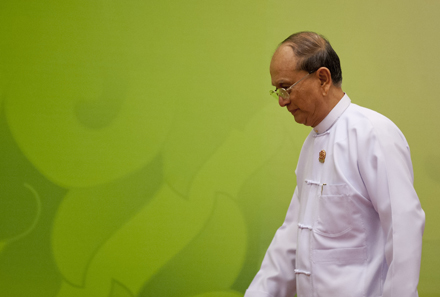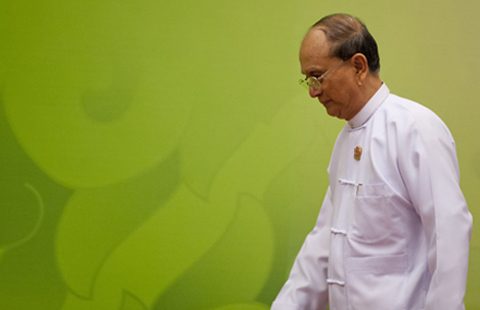
Myanmar President Thein Sein leaves after delivering the opening address at this month’s ASEAN summit. Photo by AFP.
Burma is becoming a regional player in Southeast Asia.
Just a few years ago the suggestion that Burma might become a responsible stakeholder in the Southeast Asian community would have been derided and laughed off.
Yet 2014 sees Burma chairing the Association of Southeast Asian Nations (ASEAN) for the first time. It is an unprecedented moment in the country’s history given its isolation from the international community for much of the last fifty years.
The catalyst of Burma’s emergence on to the regional stage was this month’s 24th ASEAN Summit, held in the capital Naypyitaw from 10-11 May.
It was an opportunity for the Burmese government to showcase its transition from military rule to at least nominal democratic governance. It also provided a chance to raise Burma’s regional profile among its Southeast Asian counterparts.
And there is good reason to take Burma seriously.
Its geographical position shouldering the region’s two greatest powers, India and China, is likely to become increasingly important as the two vie for influence in Southeast Asia. Burma’s economic potential as a largely untapped market (its economy grew by 7.5 percent in 2013-14) equally demands that its reputation as a backwater be reconsidered.
Burma’s foreign policy has come a long way since its independence in 1948.
During the early stages of the Cold War, Burma introduced a foreign policy of stubborn neutralism. Much to the consternation of the United States and its allies, the Burmese government rejected proposed anti-Communist security agreements and offers of development assistance. At this point, Burma’s neutralist foreign policy was directly aimed at addressing the national fear of Communist-controlled China orchestrating a proxy conflict in the country.
Isolationism only deepened after Burma fell under authoritarian military rule in 1962. When Burma’s military rulers finally decided to broaden their horizons in the early 1990s, they primarily looked towards fellow targets of Western condemnation, China and North Korea. Fast forward to the present and things appear to be changing.
Burma’s rise as a regional stakeholder is likely to also facilitate a shift in ASEAN’s diplomatic landscape.
As this year’s chair, Burma has to confront one of the most divisive issues plaguing the organisation: the ongoing territorial dispute in the South China Sea. And while there was dialogue on the issue and this month’s summit (it was one of the most prominent issues), there was no silver bullet.
That’s hardly surprising for an issue so fraught.
In a recent interview with The Irrawaddy magazine, the chairman of the government-backed Myanmar Institute of Strategic and International Studies, Nyunt Maung Shein, sought to downplay the possibility of a quick resolution to the dispute. However, Nyunt Maung Shein also emphasised the necessity for a new Code of Conduct to resolve the conflict between China and Southeast Asian states.
Although Burma has increased engagement with ASEAN since it joined in 1997, it has traditionally also maintained close relations with China. In particular, following the raft of sanctions introduced by the West in the early 1990s, China provided valuable military and economic aid to help prop up the ruling military junta.
While Burma has more recently attempted to balance growing Chinese influence by improving ties with ASEAN states, it still maintains stronger ties with Beijing than many other Southeast Asian countries. As a result, Burma could be a valuable mediator in resolving the dispute and implementing an effective Code of Conduct for the South China Sea.
In this way, Burma has held on to some aspects of its past neutralist foreign policy. By taking the middle ground between opposing sides, Burma could become a handy diplomatic asset for ASEAN to overcome some of the entrenched differences that have limited the effectiveness of the organisation.
Still, there are some considerable limitations to Burma assuming a more influential position in Southeast Asia.
The internal politics of the country remain turbulent and ethnic conflict continues to threaten stability. Recent cases of violence against Muslim minority groups and foreign aid organisations have prompted US officials to pressure the Burmese government to implement stronger measures against human rights abuses.
The continuing shadow of the military over the governance of the country is also likely to encourage scepticism at the prospect of Burma assuming a greater role in regional cooperation.
Even so, the growing power of China in Southeast Asia and its often confrontational approach to ASEAN members could be an advantageous opportunity for Burma to flex its fledgling diplomatic muscle and contribute to the resolution of territorial disputes.
On the other hand, Burma could easily return to its neutralist foreign policy tradition and play only a token role in regional affairs.
Much will depend on the trajectory of Burma’s own political development and the direction of regional tensions between Southeast Asian states and China.
If Burma plays its cards right though, it could eventually assume a desirable position as an influential middle power in Southeast Asia.
Gareth Robinson is an honours student studying Asia Pacific security at the ANU College of Asia and the Pacific. His research focuses on the history of US-Burma relations.
 Facebook
Facebook  Twitter
Twitter  Soundcloud
Soundcloud  Youtube
Youtube  Rss
Rss 